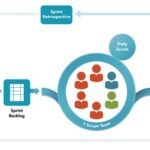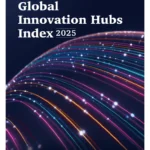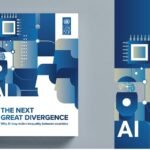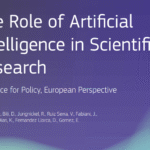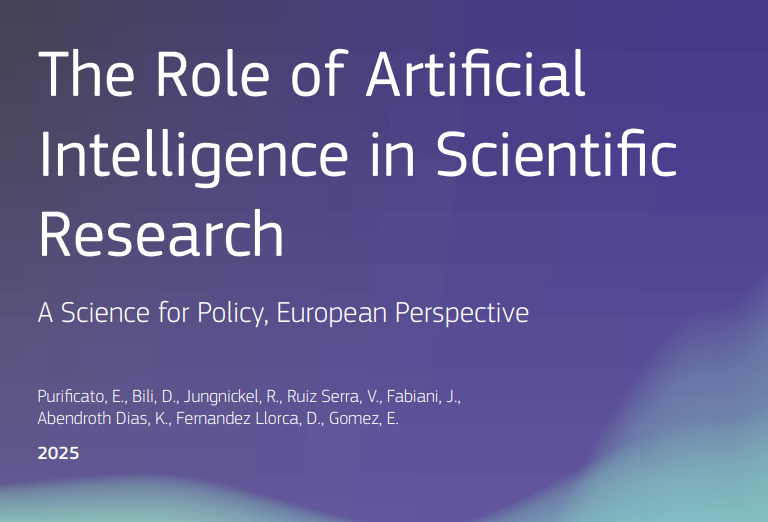
Artificial Intelligence (AI) has ceased to be a futuristic promise, becoming a present and transformative force in nearly every aspect of our lives. But what happens when this powerful tool enters the very heart of discovery: scientific research? A recent report from the Joint Research Centre (JRC), the European Commission’s science and knowledge service, titled “The Role of Artificial Intelligence in Scientific Research,” provides a detailed, evidence-based vision of this silent revolution.
This article distills the key findings of that report, exploring how AI is redrawing the map of science, what unique opportunities it offers, and which challenges we must navigate to ensure its adoption is ethical, responsible, and truly innovative. Prepare to meet the new, unexpected partner of the scientific method!
Key findings
- Comprehensive Transformation: AI is reshaping every stage of the scientific process, from generating hypotheses to communicating results and building communities.
- Discovery Accelerator: Tools like AlphaFold demonstrate AI’s power to solve complex scientific problems (protein structure prediction) and accelerate innovation (materials discovery).
- Open Science is Crucial: Progress heavily depends on open data, shared models, and collaborative infrastructures—fundamental principles for trustworthy AI in science.
- New Challenges: Significant challenges are emerging, such as algorithmic bias, “hallucinations” (fabricated data), the need for new skills, and potential epistemic drift (a shift in what we consider valid knowledge).
- Infrastructure and Talent: Strategic investment is required in high-performance computing (HPC) and in training interdisciplinary talent that combines scientific domain knowledge with AI expertise.
The scientific process under the lens of AI
The JRC report meticulously analyzes how AI—from traditional Machine Learning (ML) to Generative AI (GenAI) and Large Language Models (LLMs)—is intervening in every phase of the classic scientific method. Let’s see how:
Asking the right question (Observation and Ideation)
Traditionally, identifying knowledge gaps or formulating novel research questions depended on human intuition and exhaustive literature reviews. Today, AI acts as a “co-scientist.”
- Idea Generation: AI tools can analyze vast amounts of literature to detect underexplored areas and propose new research topics.
- Gap Identification: LLMs can synthesize information from diverse fields, identifying inconsistencies or non-obvious connections that suggest novel hypotheses, a concept known as Literature-Based Discovery (LBD).
- Creative Partner: Beyond analysis, AI is used for brainstorming, suggesting questions, or even designing conceptually new experiments, as in the case of the “Melvin” system in quantum optics.
The challenge: There is a risk that AI may reinforce existing paradigms or focus on questions where abundant data already exists, and the automated generation of complex questions still depends on human guidance.
Investigating the background (Literature Review)
The exponential volume of scientific publications makes it nearly impossible for a human to stay current. AI offers powerful solutions:
- Semantic Search: AI-based search engines (like Elicit, ORKG ASK) go beyond keywords, understanding context and generating comparative answers.
- Automated Summarization and Extraction: AI can summarize articles, extract specific data (entities, experimental results), and organize information in a structured way, facilitating meta-analysis.
- Interdisciplinary Connection: It facilitates the exploration of literature in unfamiliar fields, identifying conceptual bridges.
The challenge: The quality of the results depends on the quality of the data and models. Excessive reliance without reading the original sources can lead to “invented references” or spurious correlations (“hallucinations”).
Constructing a hypothesis
AI not only helps find questions but also assists in formulating potential answers:
- Literature-Based Hypotheses: AI systems can propose specific hypotheses by connecting previously unrelated findings in scientific literature.
- Link Prediction (ML): In fields like drug discovery, ML models predict interactions (e.g., drug-target), generating hypotheses about new candidate molecules. The discovery of the antibiotic ‘halicin’ is one example.
- Theoretical Discovery: AI is beginning to propose conjectures even in pure mathematics, identifying patterns that guide human intuition.
- Symbolic Regression: Algorithms that search for mathematical expressions to fit data, rediscovering physical laws or proposing new human-readable equations.
The challenge: AI-generated hypotheses may lack transparency or favor already-explored paths, limiting originality. Furthermore, there are concerns about undetected plagiarism.
Testing the hypothesis (Experimentation)
AI is automating and optimizing the experimental phase:
- Optimal Experimental Design: Techniques like Bayesian optimization help prioritize which experiments to conduct to gain maximum information.
- Autonomous “Self-Driving” Labs: Systems where AI proposes conditions, a robot executes the experiment, and the AI learns from the result to design the next cycle. They can multiply the speed of experimentation.
- Simulation and Data Generation: AI enables large-scale simulations (e.g., weather prediction, protein folding with AlphaFold) or generates synthetic data to train other models.
- Instrument Control: In large experiments (particle physics, astronomy), AI manages complex instruments and filters data in real-time to identify events of interest.
The challenge: Speed can compromise ethical oversight. Models may “fabricate” data if not validated, or propagate errors and biases from the code or training data.
Analyzing the Data
Perhaps the most widespread use of AI in science.
- Automated Processing: AI handles volumes and types of data (text, image, video, sensors) that overwhelm human capacity.
- Pattern Recognition: Algorithms like Deep Neural Networks (DNNs) identify subtle patterns in complex data (e.g., particle physics, galaxy classification, exoplanet discovery).
- Advanced Data Mining: ML models integrate thousands of variables (genomics, climate science) to find complex non-linear relationships.
The challenge: “Black boxes” (non-interpretable models) make validation difficult. Overconfidence in AI can diminish a researcher’s critical thinking. There is a risk of “illusions of understanding” if context is lost.
Concluding (Interpretation)
AI also assists in the interpretation of results:
- Causal Inference: Helps distinguish correlation from causation in complex data, which is crucial for robust conclusions.
- Verification and Consistency: It can verify whether new findings are consistent with existing knowledge or if they violate known physical laws.
- Collaborative Reasoning: LLMs fine-tuned with scientific knowledge can help articulate implications, suggest additional tests, or propose alternative explanations.
The challenge: Current AI often lacks deep contextual judgment. There is a danger of producing more science but understanding less, falling into methodological “monocultures.” The critical role of the human scientist is irreplaceable.
Communicating the results
AI is becoming a common tool in scientific writing:
- Writing Assistant: Helps draft, edit, improve grammar and clarity, format, and even generate sections (abstracts, related work). One study detected an unprecedented impact on scientific writing style after the emergence of ChatGPT.
- Translation and Summarization: Facilitates communication to broader audiences and breaks down linguistic barriers.
- Enhanced Visualization: Assists in generating more effective graphs and illustrations.
- Quality Control: AI tools are used to detect plagiarism or image manipulation in publications.
The challenge: Risk of “hallucinations” (invented citations, false content). Difficulty in detecting AI-generated text. Potential loss of originality and style. Questions arise regarding authorship and transparency.
Building the scientific community
Science is social. AI also impacts this dimension:
- Collaboration Networks: Algorithms that analyze publications and citations to suggest potential collaborators or identify emerging groups.
- Knowledge Repositories: Platforms like the Open Research Knowledge Graph (ORKG) use AI to structure published findings, creating “living reviews” curated by the community.
- Citizen Science: AI helps pre-filter data or validate contributions from volunteers, making their efforts more efficient.
- Peer Review: AI tools assist in assigning reviewers or detecting basic problems in manuscripts.
The challenge: Reliance on tools from private companies can create conflicts of interest or a lack of transparency. The scientific community itself must lead the discussion on how to integrate AI responsibly.
Deep Dives: Concrete Examples
The JRC report illustrates these impacts with three case studies:
Protein Structure Prediction
The Nobel-winning success of AlphaFold shows how AI (based on Deep Learning and evolutionary data) can solve a decades-old scientific challenge with near-experimental accuracy. This breakthrough, driven by open data (like the Protein Data Bank) and collaborative competitions (CASP), is accelerating biomedicine. However, challenges persist in predicting non-standard proteins, and biosecurity concerns are emerging with models capable of designing new proteins.
Materials Discovery
AI is shifting the paradigm from searching for materials by testing them one-by-one to “inverse design”: defining desired properties and using Generative AI (VAEs, GANs, diffusion models) to propose molecular or crystalline structures that meet them. Open databases like the “Materials Project” are crucial. Although the models are smaller than LLMs, integration with autonomous labs promises to accelerate discoveries for energy, sustainability, etc. It is vital to maintain rigor and avoid inflated expectations.
Archeology (Site Discovery and Inscription Restoration)
In the humanities, AI analyzes sensor data (LiDAR, satellite) to identify hidden archaeological sites. Models like Ithaca, based on Transformers, help restore damaged ancient inscriptions with accuracy surpassing human experts, in addition to attributing their geographical and temporal origins. The main challenge here is data fragmentation and the need for cultural and ethical sensitivity.
Cross-Cutting Opportunities and Challenges
Beyond the specific stages, the report identifies crucial themes:
Data, Models, and Infrastructure
Open science (data, models, code) is fundamental. Investment is needed in computational infrastructure (HPC) and high-quality databases. Scientific foundation models (large models pre-trained on scientific data) are an emerging trend, but require governance to avoid dependencies.
Skills and Innovation
Interdisciplinary talent combining scientific and AI expertise is needed. Fostering collaboration between academia and industry is key.
Ethical and Legal Considerations
Transparency, explainability, fairness (absence of bias), and human oversight are essential. The report highlights the risk of “epistemic drift”: that AI may, unintentionally, narrow the diversity of questions explored or separate conclusions from their human sources. The final responsibility always rests with the researcher. The EU AI Act establishes a framework, although research has exemptions.
Social Dimension and Collaborations
AI is not just a tool but a social force. Its use in social sciences (CSS) is double-edged: it allows for new analyses but can reinforce biases or influence society. International and cross-sector collaboration is vital to address these complex challenges.
Conclusion: Toward an AI-Augmented Science, with Responsibility
The JRC report makes it clear that AI is an unstoppable and profoundly transformative force in science. It offers unprecedented potential to accelerate discoveries, solve complex problems, and democratize access to advanced analytical tools.
However, this potential will not materialize positively on its own. It requires a proactive and coordinated approach. The resolute promotion of open science, strategic investment in infrastructure and talent, and the establishment of solid governance frameworks that prioritize ethics, transparency, and human oversight are indispensable conditions.
Editor’s Note: For the “Innovate or Die” community, the message is clear: AI is not just another tool; it is a strategic partner in the scientific innovation process. Understanding its capabilities, limitations, and risks is crucial for navigating this new era of discovery. The question is no longer if AI will change science, but how we can guide that change to maximize its benefits for research, competitiveness, and, ultimately, for society, all while keeping our ethical and human values at the center.
Reference (open access)
PURIFICATO, E., BILI, D., JUNGNICKEL, R., RUIZ SERRA, V., FABIANI, J. et al., The Role of Artificial Intelligence in Scientific Research – A Science for Policy, European Perspective, Publications Office of the European Union, Luxembourg, 2025, https://data.europa.eu/doi/10.2760/7217497, JRC143482.
Editor and founder of “Innovar o Morir” (‘Innovate or Die’). Milthon holds a Master’s degree in Science and Innovation Management from the Polytechnic University of Valencia, with postgraduate diplomas in Business Innovation (UPV) and Market-Oriented Innovation Management (UPCH-Universitat Leipzig). He has practical experience in innovation management, having led the Fisheries Innovation Unit of the National Program for Innovation in Fisheries and Aquaculture (PNIPA) and worked as a consultant on open innovation diagnostics and technology watch. He firmly believes in the power of innovation and creativity as drivers of change and development.
